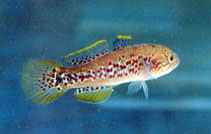| Family: |
Eleotridae (Bully sleepers) |
| Max. size: |
14 cm TL (male/unsexed) |
| Environment: |
benthopelagic; freshwater; pH range: 7; dH range: 10 - 20 |
| Distribution: |
Oceania: Murray-Darling system of Victoria, New South Wales and Queensland, Australia. Also eastern coastal drainages north of the Clarence River, New South Wales. |
| Diagnosis: |
|
| Biology: |
Inhabits slow-flowing or still waters, among weed (Ref. 7327). Occurs in rivers, creeks and billabongs, usually over rocks or among vegetation (Ref. 44894). Feeds on worms, dragonfly larvae, midge and mosquito larvae, crustaceans and mosquito fishes (Ref. 7327). Maturity: F at 4.9 cm, M at 4.5 cm. Sexually dimorphic. Direct pair spawning in rivers and ponds at 19-34°C in Dec.-Feb. A single cluster of demersal eggs laid on a solid substrate, often close to vegetation (Ref. 7276). Spawns during the rainy season (November to March). Females produce successive batches of 280-1300 eggs which are deposited on rocks, logs, or other solid debris. Males guard and fan the eggs until hatching, which takes about 3-9 days depending on temperature (Ref. 44894). Preyed on by Perca fluviatilis and competes with mosquito fish (Ref. 7329). |
| IUCN Red List Status: |
Least Concern (LC); Date assessed: 15 February 2019 Ref. (130435)
|
| Threat to humans: |
harmless |
Source and more info: www.fishbase.org. For personal, classroom, and other internal use only. Not for publication.

